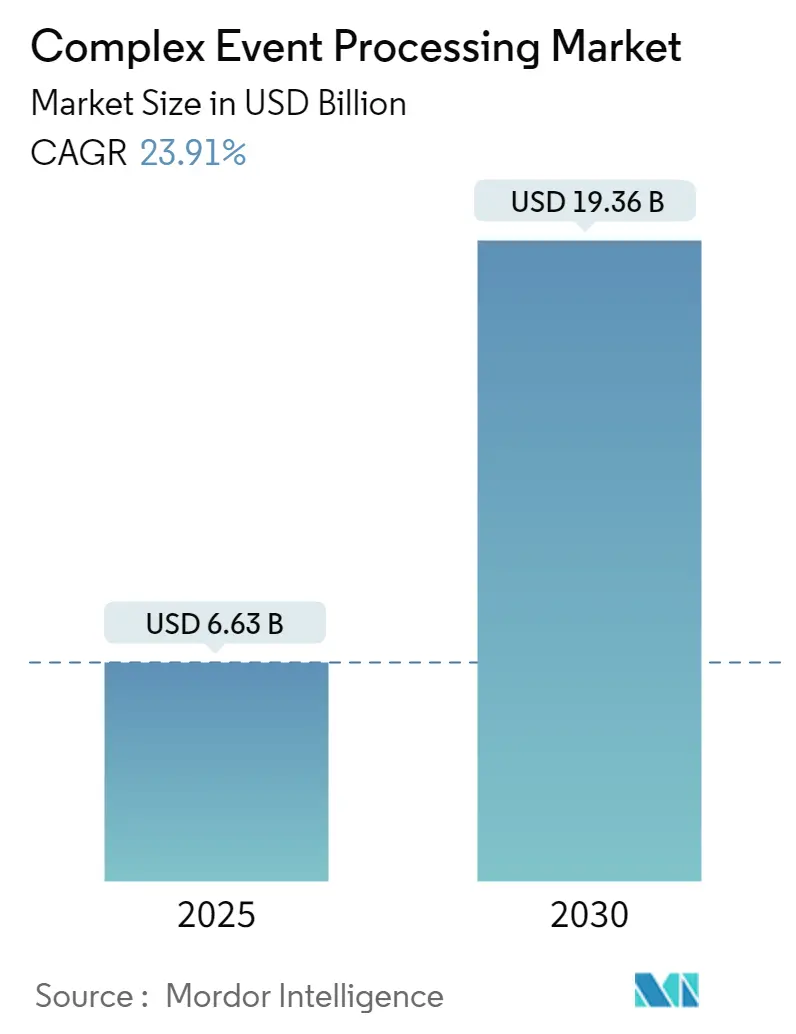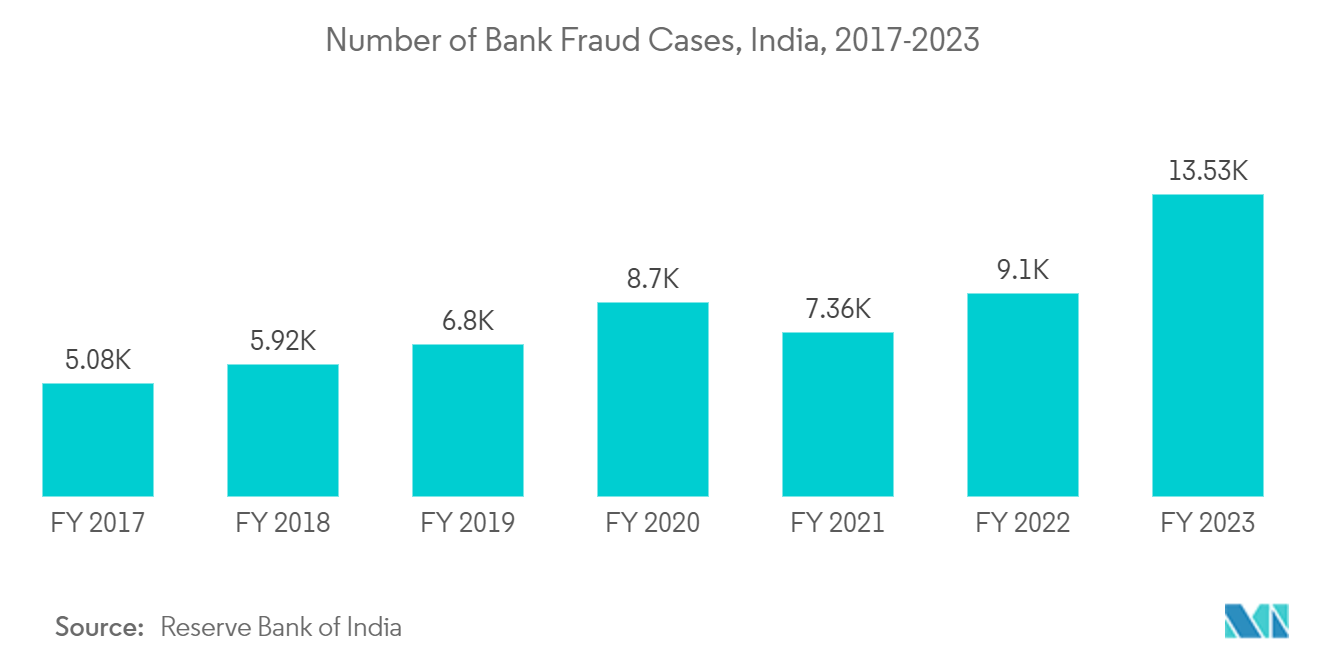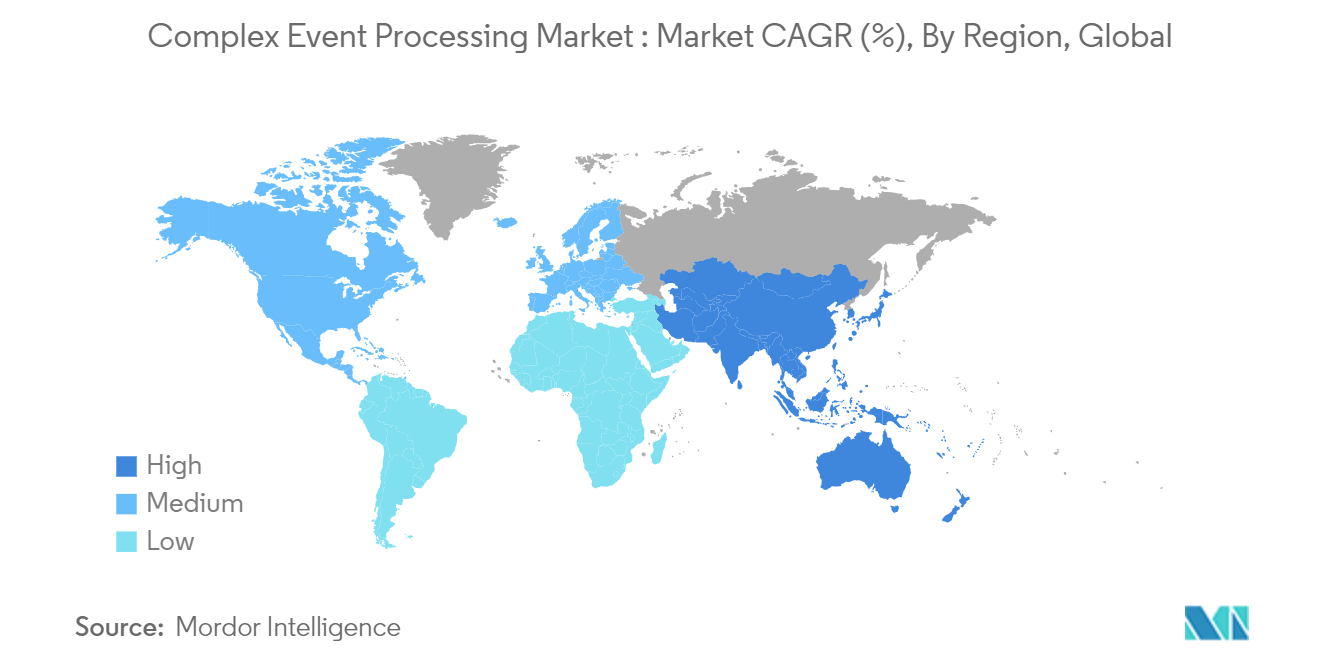Complex Event Processing (CEP) Market Analysis
The Complex Event Processing Market size is estimated at USD 6.63 billion in 2025, and is expected to reach USD 19.36 billion by 2030, at a CAGR of 23.91% during the forecast period (2025-2030).
Complex Event Processing (CEP) refers to the technology that processes and analyzes large volumes of real-time data to identify and respond to significant events or patterns. This market has gained substantial attention, particularly with the rapid advancements in machine learning and data analytics. Organizations are increasingly adopting CEP technology to enhance decision-making processes, optimize operations, and gain competitive advantages through real-time insights.
- Key Market Drivers: The rapid digitization across industries and the integration of event-driven architecture and stream processing platforms are key factors driving the CEP market growth. As organizations strive to streamline business process automation, the demand for scalable and low-latency event stream analytics solutions continues to rise.
- Industry Applications: CEP technology plays a pivotal role in industries requiring real-time data processing, such as finance, telecommunications, and healthcare. The need for complex event patterns detection and the increasing adoption of distributed event processing systems underscore its growing relevance.
- Emerging Technologies: The market is witnessing a surge in the integration of predictive analytics with CEP, enabling organizations to anticipate potential issues and mitigate risks effectively. This synergy enhances the appeal of CEP solutions, contributing to their broader adoption across various sectors.
- Competitive Advantage: By utilizing CEP technology, companies can improve operational efficiency and reduce latency in decision-making. The capability to process real-time data allows businesses to respond swiftly to critical events, providing a significant competitive edge in the market.
Enhancing Operational Efficiency Through Real-Time Analytics
The growing need for real-time data processing is one of the primary factors driving the adoption of Complex Event Processing (CEP) solutions. Real-time analytics allows organizations to process data as it is generated, leading to quicker insights and more informed decision-making.
- Financial Sector Needs: In sectors like finance and telecommunications, where milliseconds can impact outcomes, the ability to analyze data instantaneously is crucial. CEP enables businesses to monitor, analyze, and respond to events as they occur, which is vital for industries that require rapid data processing.
- Event-Driven Systems: By utilizing event-driven systems, companies can optimize their operations and reduce the time it takes to identify and address critical events. This capability is particularly beneficial in managing high-frequency trading systems and real-time customer interactions.
- Integration of Stream Processing: The integration of stream processing platforms with CEP technology further enhances the ability of organizations to manage and process vast amounts of data in real time, thereby improving operational efficiency and responsiveness.
- Operational Benefits: As a result, industries relying on real-time data processing, particularly in finance and telecommunications, continue to invest in CEP solutions to maintain operational agility and responsiveness.
Challenges in Achieving Consistency in Results
Despite the numerous advantages of CEP, one of the significant challenges faced by organizations is the lack of consistency in results. Achieving reliable and repeatable outcomes from CEP solutions requires fine-tuning and continuous monitoring, which can be resource-intensive.
- Complex Event Patterns: Inconsistent results can arise from various factors, such as the complexity of event patterns, the quality of input data, and the system's ability to process events in real time. This inconsistency can lead to false positives or missed opportunities, undermining the effectiveness of CEP solutions.
- Distributed Event Processing: The challenge of ensuring consistent outcomes is exacerbated when dealing with distributed event processing across multiple systems. Variability in network performance, data quality, and processing power can all contribute to fluctuations in the accuracy of CEP results.
- Investment in Data Integration: To mitigate these issues, organizations must invest in robust data integration tools and predictive analytics that can enhance the reliability of CEP outcomes. Additionally, ongoing maintenance and calibration of CEP systems are essential to achieving consistent performance.
- Reliability Focus: By addressing these challenges, businesses can maximize the benefits of CEP technology, ensuring more reliable real-time analytics and event-driven decision-making.
Complex Event Processing (CEP) Market Trends
BFSI End-user Segment to Grow Significantly
- BFSI Segment Growth :The Banking, Financial Services, and Insurance (BFSI) sector is increasingly dependent on CEP technology for real-time data analysis, fraud detection, and risk management. As financial institutions strive to process vast amounts of data instantaneously, the demand for CEP technology is on the rise.
- Advanced Fraud Detection: CEP software enables financial institutions to monitor and analyze large volumes of transactions in real-time, allowing for immediate identification and response to fraudulent activities. This is particularly critical for minimizing risks and enhancing decision-making.
- Blockchain Integration: The adoption of blockchain technology by banks and trading companies is further fueling the use of CEP systems. These systems are instrumental in managing the digital transaction lifecycle, ensuring the security and efficiency of financial operations.
- Positive Market Outlook: The increasing focus on process automation and predictive analytics will contribute to the steady expansion of the CEP market, with industry reports forecasting a rise in market value over the coming years.
North America Expected to Hold Major Market Share
- North America is anticipated to dominate the global CEP market, largely due to its early adoption of CEP technologies. The region has a robust IT infrastructure and a strong presence of leading CEP technology providers.
- Early Adoption: The widespread use of CEP in various applications, from real-time data processing to event stream analytics, further solidifies North America's leadership position in the global market.
- R&D Investments: The United States and Canada are at the forefront of developing advanced CEP solutions, with significant investments in research and development. These efforts have led to the creation of scalable and distributed event processing systems, essential for managing the vast amounts of data generated by businesses.
- Financial Services Application: The financial sector in North America is a significant consumer of CEP technology. The region's focus on enhancing decision-making processes through advanced data integration tools and predictive analytics has driven the adoption of CEP solutions.
- Continued Market Growth: As more businesses recognize the importance of real-time data insights, North America is expected to maintain its leadership position, significantly contributing to the overall growth of the CEP market.
Complex Event Processing (CEP) Industry Overview
The Complex Event Processing (CEP) market is moderately consolidated, with a few large players holding a significant market share. Global conglomerates and specialized software companies dominate this space, leveraging their extensive experience and resources to maintain leadership.
Market Leaders: Prominent players such as IBM Corporation, SAP SE, Oracle Corporation, Tibco Software Inc., and Software AG lead the market. These companies offer comprehensive CEP solutions that cater to a wide range of industries, including finance, telecommunications, and manufacturing.
Technological Capabilities: Their strengths lie in their advanced technologies, extensive customer base, and strong global presence. These leaders continue to innovate and expand their portfolios, ensuring they remain at the forefront of the market.
Key Trends: One of the major trends in the CEP market is the increasing integration of artificial intelligence (AI) and machine learning (ML) to enhance data processing capabilities. Developing scalable, real-time analytics platforms that can handle the growing volume and complexity of event data is crucial for success.
Strategies for Success: Expanding partnerships and ecosystems will be crucial for companies looking to broaden their market reach and offer more integrated solutions. A commitment to continuous innovation and adapting to emerging technologies will be essential for sustaining a competitive edge in this market.
Complex Event Processing (CEP) Market Leaders
-
IBM Corporation
-
SAP SE
-
Oracle Corporation
-
Tibco Software Inc.
-
Software AG
- *Disclaimer: Major Players sorted in no particular order
Complex Event Processing (CEP) Market News
- June 2024 - Cisco Unveils AI-Driven Innovations and a USD 1 Billion Global Investment Fund; The fund aims to propel industry innovation, enhance customer preparedness, and bolster Cisco's commitment to ensuring organizations thrive in an AI-centric future.
- May 2024 - ServiceNow and Fujitsu Limited have announced a strategic partnership aimed at delivering innovative solutions across diverse industries, ultimately enhancing value for customers globally. As part of this collaboration, the companies will launch a new Fujitsu-ServiceNow Innovation Center, emphasizing digital transformation and prioritizing customer success. Additionally, Fujitsu plans to intensify its use of the Now Platform, specifically honing in on the manufacturing sector to provide solutions for Engineering Chain Management (ECM) and Supply Chain Management (SCM) operations.
Complex Event Processing (CEP) Industry Segmentation
Complex event processing (CEP) is a system that aggregates, processes, and analyses massive streams of data to get real-time insights from events as they happen, The increasing complexity of industrial automation software solutions and the need for real-time analytics demand CEP solutions across industries. The scope of the study for the complex event processing market has considered services and software solutions for different types of enterprises across the end-user verticles globally.
The complex event processing market is segmented by type (services, software), type of user (small and medium enterprise, large enterprise), end-user vertical (BFSI, retail, government and defense, healthcare), and geography (North America, Europe, Asia-Pacific, Latin America, Middle East, and Africa). The market sizes and forecasts are provided in terms of value (USD) for all the above segments.
| By Type | Software |
| Services | |
| By Enterprise Type | Small and Medium Enterprise |
| Large Enterprise | |
| By End-user Vertical | BFSI |
| Managed Mobility | |
| Government and Defense | |
| Retail | |
| Healthcare | |
| Telecom and IT Industry | |
| Media and Entertainment | |
| Manufacturing | |
| Other End-user Verticals | |
| By Geography*** | North America |
| Europe | |
| Asia | |
| Australia and New Zealand | |
| Latin America | |
| Middle East and Africa |
Complex Event Processing (CEP) Market Research FAQs
How big is the Complex Event Processing Market?
The Complex Event Processing Market size is expected to reach USD 6.63 billion in 2025 and grow at a CAGR of 23.91% to reach USD 19.36 billion by 2030.
What is the current Complex Event Processing Market size?
In 2025, the Complex Event Processing Market size is expected to reach USD 6.63 billion.
Who are the key players in Complex Event Processing Market?
IBM Corporation, SAP SE, Oracle Corporation, Tibco Software Inc. and Software AG are the major companies operating in the Complex Event Processing Market.
Which is the fastest growing region in Complex Event Processing Market?
Asia Pacific is estimated to grow at the highest CAGR over the forecast period (2025-2030).
Which region has the biggest share in Complex Event Processing Market?
In 2025, the North America accounts for the largest market share in Complex Event Processing Market.
What years does this Complex Event Processing Market cover, and what was the market size in 2024?
In 2024, the Complex Event Processing Market size was estimated at USD 5.04 billion. The report covers the Complex Event Processing Market historical market size for years: 2019, 2020, 2021, 2022, 2023 and 2024. The report also forecasts the Complex Event Processing Market size for years: 2025, 2026, 2027, 2028, 2029 and 2030.
Our Best Selling Reports
Complex Event Processing Industry Report
Our industry analysis on the Complex Event Processing (CEP) market offers an in-depth exploration of the current market trends, technological advancements, and industry dynamics. The report delves into the critical drivers, such as the adoption of event-driven architecture and stream processing platforms, which are fueling the demand for CEP technology. Our research comprehensively covers the implications of real-time data processing across key sectors, including finance, telecommunications, and healthcare, highlighting the strategic importance of CEP technology in enhancing operational efficiency and decision-making.
Stakeholders will benefit from our detailed market overview, which provides insights into the growth trajectory and future potential of CEP solutions. The report includes an examination of emerging trends, such as the integration of predictive analytics in CEP, and offers actionable intelligence on how businesses can leverage these technologies to maintain competitiveness. All findings and analyses are available in an easy-to-read report pdf, ensuring that stakeholders have access to the most relevant industry statistics, market forecasts, and strategic recommendations for optimizing their investment in CEP technology.
Statistics for the 2024 Complex Event Processing market share, size and revenue growth rate, created by Mordor Intelligence™ Industry Reports. Complex Event Processing analysis includes a market forecast outlook to 2029 and historical overview. Get a sample of this industry analysis as a free report PDF download.

-Market-company-loog.webp)



-Market-ompetive-logo.webp)

